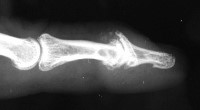- Surgery is rarely required for this condition unless the end joint (D.I.P. joint) is dislocated or the fracture involves > 50% joint surface. Surgery often results in permanent loss of bending (flexion) of the end joint & the results of treatment in a splint are very good for most Mallet fingers if the program is carefully followed.
1. Fracture involving > 50% joint surface



2. Fracture dislocation of the D.I.P. joint.
This is uncommon.



Problems with Surgery:
Conceptually this surgery is straight forward but technically it is difficult. With all fractures the joint alignment must be restored to prevent late onset arthritis. In Mallet finger surgery the ability to see the joint surface is very difficult because of the anatomy.
The Nail bed limits access beyond the fracture. Any damage to the nail bed can result in nail deformity. In particular it is common to have a transient ridge in the nail which gradually grows out over a period of months.


The extensor tendon attachment to the bone fragment is broad and prevents direct visualisation of the joint proximal to the fracture.
The incision requires one to cut the tiny nerve branches at the base of the nail. This can result in permanent numbness at the base of the nail and the potential for a Tender scar
Late presentation:
Often patients present late after their injury and this creates extra problems.
- Bone resorption occurs at the fracture and so even with accurate alignment of the fracture one can end up with a step in the joint surface.
See diagram.




Post operatively the finger can be exercised immediately if the fixation is stable. Occasionally additional splintage is required such as a Rheenatherm splint or a wire inserted across the joint for a few weeks.


If a step remains in the joint surface arthritis can develop. To treat the arthritis requires stiffening ( Fusion) of the D.I.P. joint. ie the arthritis is removed and the joint can no longer move.


LAST UPDATED ON S29 / 3 / 15
